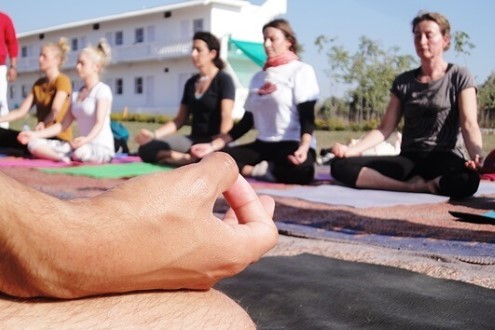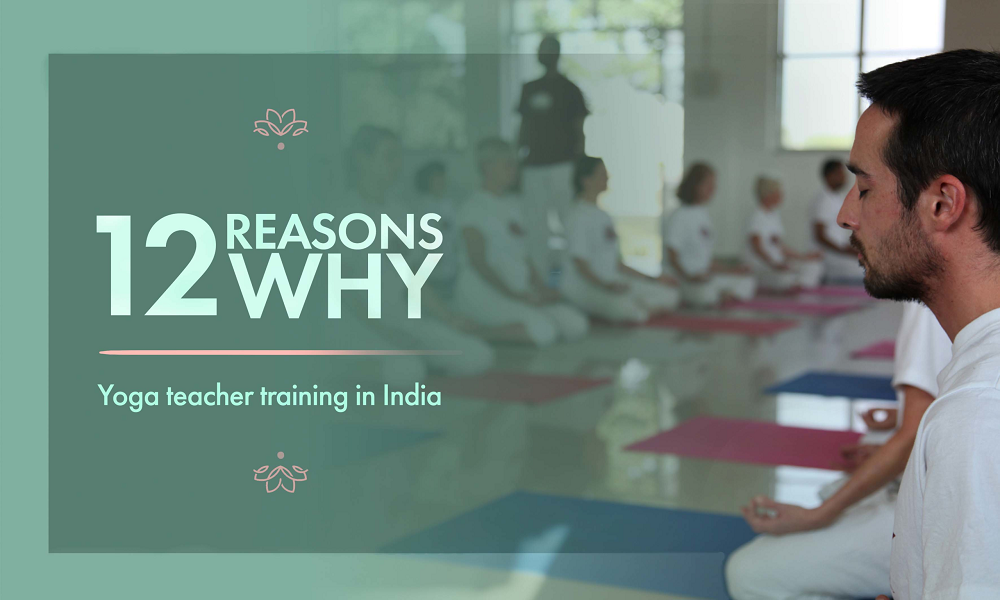India is the birthplace of yoga. Yoga began in India about 10,000 years ago. Ancient monks and sages developed yoga asanas for the well-being of their bodies. It was essential for them to keep their bodies fit and disease-free in order to achieve higher stages of meditation and eventually Samadhi. Yoga when practised properly helps to keep the body healthy and young. Even today it is a dream of every serious yoga practitioner to study yoga in India.
Why Study Yoga in India
Are you thinking about pursuing yoga teacher training? You're not the only one! There are hundreds if not thousands of yoga teacher training programs all around the world and it may be daunting to ultimately choose one.
Did you know that every year thousands of people come to study yoga in India. According to a report of the Indian Foreign ministry, in the year 2013 more than 9,000 people visited India for studying yoga. These numbers are growing steadily, and rightfully so. India is the birthplace of yoga but that’s not the only reason why you should definitely consider India for your yoga teacher certification.
12 Reasons why going to the motherland of yoga may be the place for you
1 -Learn the Philosophy of Yoga & Authentic Yoga Teachings
India is the place where yoga originally comes from. So when you go to India, you will actually learn about yoga from the source. The foundations of yoga are thought to date back at least 5000 years. Teachings on yoga first appeared in the Vedas, ancient philosophical texts from India, and later in the Upanishads and the Bhagavad Gita. Later, more extensive descriptions were recorded in the Yoga Sutras by Patanjali. In contrast, it is only about 200 years ago that yoga was introduced in the West.
Yoga philosophy is deeply rooted in the culture of India. Therefore, teachers who have grown up or lived in this culture themselves have a profound understanding of yoga as a lifestyle and not merely a physical practice. They will help you to integrate the teachings of yoga into every aspect of your life, not just the practice on your mat. You will also learn about the rich background, history and the traditional approach to yoga. Learning yoga from the source will enable you to provide more depth and insight as you start to teach.
In the rest of the world, yoga is mostly known for its use as a form of physical exercise. But in India, yoga is practised as a lifestyle, as a way of life. Therefore when you learn yoga in India you also understand the underlying philosophy of Yoga. In order to reap the full benefits of yoga - to experience the tremendously positive effects of yoga - it is very imperative to understand the philosophy and lifestyle of yoga. When you study yoga in India, you will understand the right reason and right way to do yoga and its various practices like Pranayama (Life-force expansion exercises), Dharana (concentration) and Dhyana (meditation)
Read more: What are the Eight Limbs of Yoga?
2 –Experience the Ashram Life in the Right Environment
When choosing India as your destination for your yoga teacher training, you will most likely live in an ashram for at least a month. Living in an ashram is a unique experience, helping you to dive deeper into your training. An ashram is a residential school, a place that is solely focused on learning. It is therefore simple and minimalist, without unnecessary luxuries. Living in an ashram also means you will stick to a structured and disciplined program, based on the yogic lifestyle. Living in an ashram in India will:
- Help you to take a step back from your routines in your daily life and develop new, healthy habits.
- Allow you to experience more balance in your body and mind.
- Challenge you to grow, not only physically, but mentally and spiritually all the more.
3 - You Will Expand your Comfort Zone
You will be far away from home, in a completely different environment than you are used to. A yoga teacher training in India therefore can be an immense challenge for your comfort zone. Expanding our comfort zone is an effective way to work on personal growth. Going out of your comfort zone might cause temporary fear or anxiety. It, therefore, takes courage to do so. But once you have taken this step, it will show you your inner strength and help you to overcome fear in future challenges.
4 - You Will Develop Structure and Discipline to Reach your Goals
India is well-known for its strict and result-driven educational system. Discipline and structure are therefore important ingredients during a yoga teacher training at an ashram in India. The structured program at an ashram will help you to fully focus on your learning process. There is hardly any distraction, as you are away from home and not connected to the internet most of the time. A 200-hour yoga teacher training in a month can be intense, but with no other obligations or activities, you will be able to learn much more than you could ever imagine. The structure of the program will enable you to learn and practice in a dedicated way. There is nothing else you must do or think about; completing your yoga certification course is your only and most important purpose during your stay.
5 - You Will Meet Like-minded People from all over the World
As India is a popular destination for following a yoga teacher training, you will find yourself in an international group. People from all over the world travel to India to learn about yoga. This diversity in the groups offers many different perspectives on life. As you study and live together, it is mind-opening to exchange ideas and experiences. This international character not only enriches the teacher training experience, you will also build new friendships that might last for the rest of your life.

6 – You can Combine your Teacher Training in India with Travelling
Going to India for your yoga teacher training has many advantages. If you like to travel, this is a very important one. Travelling can be another way to learn about yourself and change your life. India is a country with many different faces, full of experiences and challenges. Travelling in India means learning new lessons, as well as deepening those you have learned during the yoga teacher training. You will see things that make you reflect and gain new perspectives. Therefore, travelling in India and following a yoga teacher training perfectly complement each other
A few places in India are especially famous in the yoga world. You might be interested in visiting places like Rishikesh, Goa, Dharamsala and Kerala to extend your knowledge and experience.
7 - You Will Start an Ongoing Process of Self-development
For many people, a yoga teacher's training signifies a change in their life. It might be the start of a new beginning or a dream coming true. It could also simply mark the choice to finally start following your heart. The teachings of yoga in India help you to reflect and spark an ongoing process of self-development. What is meant exactly by the ‘Self’ is at the core of yoga. You will definitely learn more about this question in yoga teacher training in India.
Read more: The Seven Stages of Knowledge

8 – With a Yoga Teacher Training in India you can Benefit from Attractive Pricing
Another reason to choose a yoga teacher training in India can be the relatively lower price. A yoga teacher's training is always a significant investment. However, as costs for living and accommodation are significantly lower in India, the total price will be cheaper. Some courses include everything, others require additional booking of accommodation and meals. But even if you add the costs of your flight and visa, you can do teacher training in India on a lower budget than in the West!

Get a free copy of our Amazon bestselling book directly into your inbox!
Learn how to practice, modify and sequence 250+ yoga postures according to ancient Hatha Yoga principles.
9 - You Will Reconnect with Nature and Yourself
India has a vast and varied landscape, and although it has a large population, you can find remote places in more rural areas as well. For example, the Arhanta Yoga Ashram India is located about 20 km away from the town of Khajuraho. It is surrounded by lush nature and a peaceful environment. The hills, green fields and the river create a calm and serene atmosphere - the perfect place to practice yoga. The ashram itself reflects the same peace and quiet, aiding you to turn your attention inward and find the focus to learn.


10 – Live the Yogic Lifestyle
Following a yoga teacher training in India allows you to live a yogic lifestyle. In India, you will get the right environment for learning and practising Yoga. The best place to learn yoga is a Yoga ashram. A Yoga ashram is a place where the practitioner gets a chance to live next to the teacher and follows intensive yoga practice. The Yoga ashram provides a distraction-free environment where everybody has a similar goal of learning and studying yoga. The complete daily routine is structured around learning and practising the principles of Yoga
The yogic lifestyle involves getting up at sunrise, eating a balanced diet and engaging in physical activity as well as rest. This is based on the 5 points of yoga:
- Proper exercise (asanas)
- Proper breathing (pranayama)
- Proper relaxation (savasana)
- Proper diet (vegetarian)
All of these elements are included in the structured program at the ashram. You will often start with meditation early in the morning, which is a good way to develop the habit of daily practice at the start of your day. The daily yoga asana classes will allow you to improve your own practice considerably throughout the teacher training. The meals that you eat, mostly in silence, are purely vegetarian, nourishing and healthy. You will notice the effects of consistently eating a balanced diet over the course of a month. Altogether, the yogic lifestyle helps you to build new, healthy habits. You will feel better in your body and mind. This is a good foundation for your yoga practice and a healthy lifestyle in the long run.
Read more: What to Expect at a Yoga Ashram?
11 – Gain a Proper Understanding of Yoga Philosophy
Educational systems are different all around the world. In India, the traditional way of learning at an ashram is called the Gurukula system. Children would be sent to an ashram to live, study and work with the main teacher (guru) for several years. They were expected to be part of the community, not only doing their schoolwork but also participating in maintenance duties. In India, teachings are often based on this system. During a yoga teacher training, you will have the opportunity to be part of the community in the ashram, working, living and learning together.
All ancient yoga texts and books were written in ancient languages like Sanskrit and Prakrit. In India, yoga teacher trainers study these texts in their original language therefore their understanding of these texts is more accurate. And consequently, their understanding of the principles and practices of yoga is also more accurate. When you study with a yoga teacher in India you get a proper understanding of yogic principles.
12 – Have the Experience of a Lifetime
Travelling to India and following a yoga teacher training are both experiences that can radically change your life. Gaining new insights, overcoming challenges and meeting like-minded people are all things that will make memories that you take with you forever. In India, many teachings are based on something inside of you.
Most of the people, who choose to go to India to study yoga want to experience authentic yoga. There are different yoga styles popular these days; Hatha Yoga, Ashtanga Yoga, Kundalini Yoga, Vinyasa Yoga, Integral Yoga, Iyengar Yoga etc. Most of these styles have been developed in India by Indian yoga masters. People come to India to experience these yoga styles and get first-hand teachings directly from the masters or their students. You can therefore discover yoga, which has not changed its original form during the rise of yoga in the West.
Study Yoga at Arhanta Yoga Ashram in India
The Arhanta Yoga Ashram in India teaches authentic Classical Yoga and Hatha Yoga. Our courses are suitable to beginners as well as an advanced yoga practitioners. The ashram provides an ideal location to study and concentrate on the yogic practices and learning philosophy and background of Yoga.
India is the birth place of yoga. Yoga began in India about 10,000 years ago. Ancient monks and sages developed yoga asanas for the well-being of their bodies. It was essential for them to keep their bodies fit and disease free in order to achieve higher stages of meditation and eventually Samadhi. Yoga when practiced properly helps to keep the body healthy and young. Even today it is a dream of every serious yoga practitioner to study yoga in India.

Get a free copy of our Amazon bestselling book directly into your inbox!
Learn how to practice, modify and sequence 250+ yoga postures according to ancient Hatha Yoga principles.

